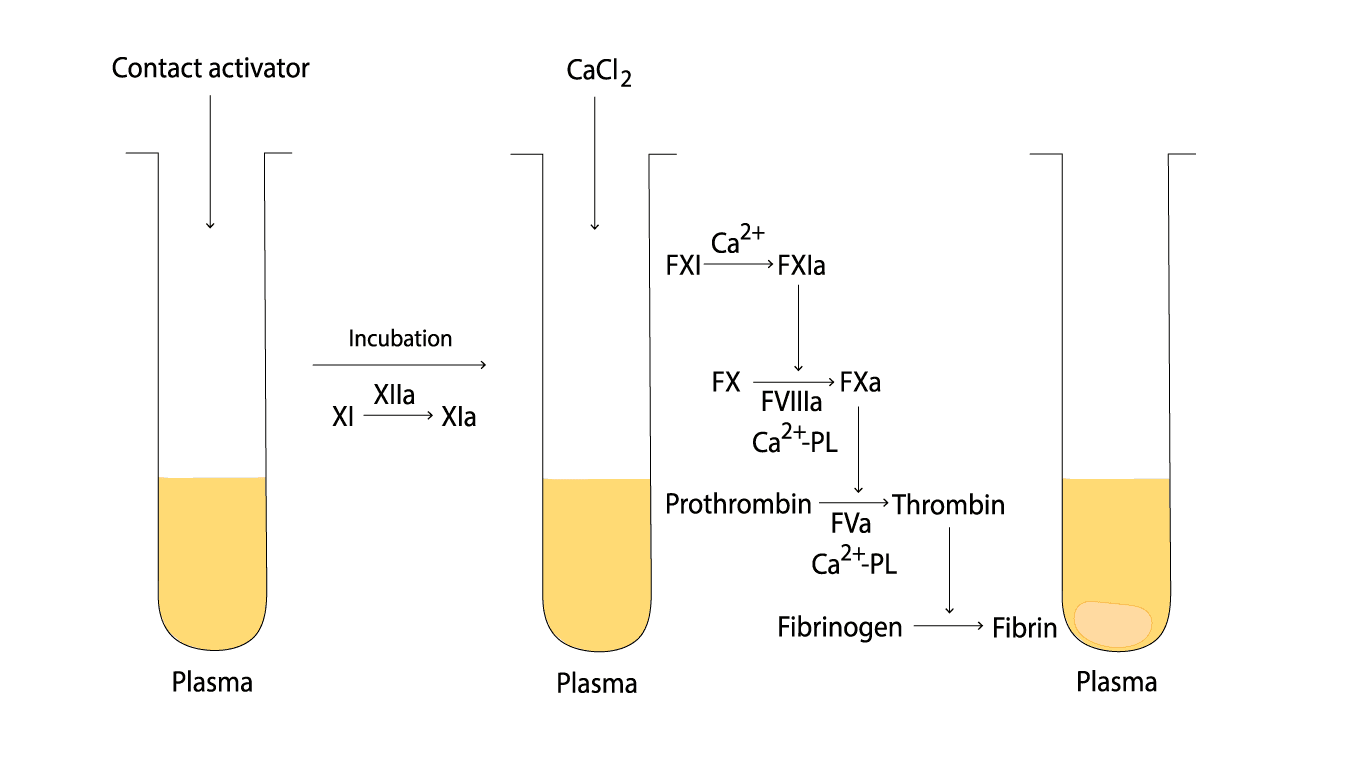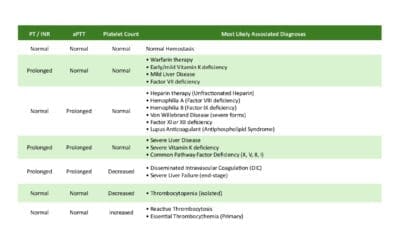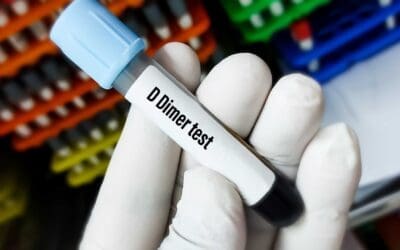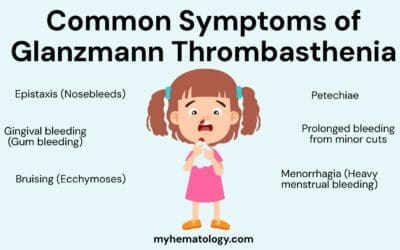Introduction
The activated partial thromboplastin time (aPTT) blood test measures how long it takes for a blood clot to form. It is one of the most common blood tests performed, and it is used to diagnose and monitor a variety of bleeding and clotting disorders.
The activated partial thromboplastin time (aPTT) blood test works by measuring the amount of time it takes for fibrinogen to be converted to fibrin. Fibrinogen is a protein that is produced by the liver, and it is essential for blood clotting. Fibrin is the main component of blood clots.
The activated partial thromboplastin time (aPTT) blood test is performed by mixing a sample of the patient’s blood with a reagent that contains a phospholipid and a contact activator. The phospholipid provides a surface for the coagulation factors to assemble on, and the contact activator activates the intrinsic coagulation pathway. The intrinsic coagulation pathway is one of two pathways that lead to blood clot formation.
The time it takes for a clot to form is measured in seconds. The normal range for the activated partial thromboplastin time (aPTT) blood test is 25 to 35 seconds. A prolonged activated partial thromboplastin time (aPTT) indicates that it is taking longer for the blood to clot than normal. This can be caused by a variety of factors, including:
- Disseminated intravascular coagulopathy (DIC)
- Other bleeding disorders
- Liver disease
- Certain medications, such as heparin and warfarin
The activated partial thromboplastin time (aPTT) blood test is a valuable tool for diagnosing and monitoring bleeding and clotting disorders. It is also used to monitor the effectiveness of blood thinners, such as heparin.
Principle of Activated Partial Thromboplastin Time (aPTT) Blood Test
Activated partial thromboplastin time (aPTT) blood test measures the plasma clotting time after the activation of contact factors (prekallikrein (high molecular weight kininogen [HMWK]) > kallikrein > FXII > FXIIa) without added tissue thromboplastin, indicating the overall efficiency of the intrinsic pathway.
Activated partial thromboplastin time (aPTT) blood test is performed by pre-incubating the plasma with a contact activator i.e. kaolin or elagic acid to activate the contact factors. This will produce factor XIIa, which cleaves factor XI to factor XIa. Calcium is absent during this phase to prevent coagulation.
After adding calcium, factor XIa activates factor IX, and coagulation proceeds. Phospholipid is added to allow the test to be performed on platelet-poor plasma. The aPTT assay depends on contact factors, factors VIII and IX, and reactions with factors X, V, prothrombin, and fibrinogen. It is also sensitive to the presence of circulating anticoagulants (inhibitors) and heparin.
Method differs slightly according to the manufacturer’s protocol.
Materials
- #Platelet poor plasma (PPP) of patient and control. PPP is prepared by centrifuging the peripheral blood at 2000 g for 15 minutes at room temperature.
- *Activator-phospholipid solution
- *0.025 mol/L calcium chloride (CaCl2)
- *Glass tubes 5 ml
- *Water bath
- Stopwatch
- Timer
- Pipettes 100 – 200 ul
- Pipette tips
*These items must be at 37°C.
#PPP must be kept at room temperature to prevent activation of factor VIII which may cause an inaccurate timing result.
Protocol

The addition of activator and phospholipid to the platelet-poor plasma initiates the intrinsic coagulation pathway. This pathway involves a series of enzymatic reactions, leading to the formation of thrombin, the enzyme responsible for converting fibrinogen to fibrin, the insoluble clot.
This test must be performed in the water bath at all times apart from the observation of the clot formation step.
- Add 0.1 mL plasma of both patient and control into a test tube, respectively and label accordingly. Have the timer set for 3 minutes.
- Add 0.2 mL of activator-phospholipid solution into each test tube and immediately start the timer.
- Incubate the tubes in the water bath for 3 minutes with occasional gentle agitation.
- Get the stopwatch ready, add 0.1 mL CaCl2 and immediately start the stopwatch.
- Gently mix the solution in the test tubes by tilting the test tubes to 45° angle and agitate lightly.
- Intermittently take the tubes out of the water bath to observe for the first sign of clot formation.
- Stop the timer and record the time at the first sign of clot formation.
- Test both patient and control plasma in duplicates and record the average time.
Interpretation
Reference range for activated partial thromboplastin time (aPTT) is 26 – 40 seconds.
A prolonged activated partial thromboplastin time (aPTT) indicates that it is taking longer for the blood to clot than normal. This can be caused by a variety of factors, including:
- Administration of heparin or contamination with heparin
- Liver disease
- Circulating anticoagulants
- Deficiency of a coagulation factor other than factor VII
- Massive blood transfusion using stored blood.
- Disseminated intravascular coagulation (DIC)
Frequently Asked Questions (FAQs)
What is the difference between PT and aPTT?
PT (Prothrombin Time) and APTT (Activated Partial Thromboplastin Time) are both blood tests used to evaluate blood clotting ability. However, they assess different parts of the clotting process.
PT (Prothrombin Time)
- Measures the extrinsic and common pathways of the clotting cascade.
- Primarily used to monitor patients on warfarin (a blood thinner).
- Evaluates factors II, VII, and X, as well as fibrinogen.
aPTT (Activated Partial Thromboplastin Time)
- Measures the intrinsic and common pathways of the clotting cascade.
- Primarily used to monitor patients on heparin (another blood thinner).
- Evaluates factors XII, XI, IX, VIII, X, V, II, and fibrinogen.
What are the coagulation factors related to aPTT?
The aPTT (Activated Partial Thromboplastin Time) test evaluates the functionality of several clotting factors involved in the intrinsic and common pathways of the coagulation cascade. These factors include:
- Factor I: Fibrinogen
- Factor II: Prothrombin
- Factor V
- Factor VIII
- Factor IX
- Factor X
- Factor XI
- Factor XII
By assessing the time it takes for blood to clot after adding specific reagents, the aPTT test helps identify deficiencies or abnormalities in these clotting factors.
What is a critical activated partial thromboplastin time (aPTT) level?
A critical activated partial thromboplastin time (aPTT) level is generally considered to be above 70 seconds. This indicates a significantly prolonged clotting time and carries a high risk of spontaneous bleeding.
It’s important to note that this is a general guideline, and specific critical values might vary slightly between laboratories.
Does activated partial thromboplastin time (aPTT) change with age?
Yes, activated partial thromboplastin time (aPTT) can change with age.
- Children: Generally have longer activated partial thromboplastin time (aPTT) values compared to adults due to lower levels of certain clotting factors.
- Adults: Activated partial thromboplastin time (aPTT) values tend to be relatively stable.
- Elderly: There’s some evidence suggesting that activated partial thromboplastin time (aPTT) might slightly increase with age, but this is less pronounced than the changes seen in children.
It’s important to note that these are general trends and individual variations can occur. Other factors such as underlying health conditions, medications, and laboratory methods can also influence activated partial thromboplastin time (aPTT) blood test results.
Disclaimer: This protocol is intended for informational purposes only and may need to be modified depending on the specific laboratory procedures and patient circumstances. Always consult with a qualified healthcare professional for guidance. See additional information.



